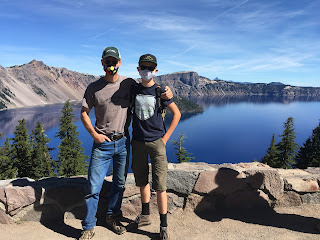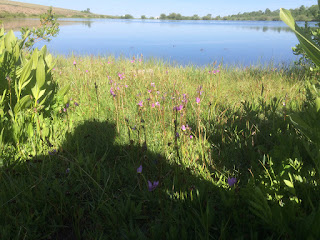Fort Rock is a highly accessible and beautiful rock formation the middle of high desert country. The volcanic formation sits to the northwest of Christmas Valley. The formation is designated a natural area and is managed as a state park. You can visit dawn to dusk. There is a restroom, some picnic tables and a park host.
The park is surrounded by hay farms, and, hence, a variety of ground squirrels, jack-rabbits and other small mammals. The rodent population attracts large birds of prey - some of whom nest at Fort Rock. We spotted a newly deceased Great Horned Owl below what appeared to be a cliff-side nest. Perches have been added to electrical poles in the area. Along the highway, we spotted a bald eagle, golden eagle, and a ferruginous hawk.Circling close to Fort Rock were prairie falcons, vultures, and raven.
The entire rock formation can be hiked within a few hours. There were several highlights for us. We enjoyed yelling across the formation and hearing our voices echo back. The rock itself is pretty interesting - with a variety of vesicles forming patterns in different section of rock. If you walk close to the rock, it is possible to find several locations where owls drop pellets and thousands of small bones. Walking to the top of Fort Rock, you will be able to peer over the sheer outer rock face. The rock itself has a hollow sound to it when you knock on it.
On our hike, we spotted a few lizards, birds, and jack-rabbits. It also looks like prime rattlesnake habitat.
If you want to camp in the area, north of Fort Rock about five miles is the Cabin Creek Campground - a rough camping area. The campground offers a beautiful Ponderosa pine forest - but not water or toilets. At the south side of the campground are some Forest Service buildings and two bird blinds. We spotted nut-hatches, nutcrackers, mountain bluebirds, and chickadees. We also heard flickers. The mammal population seemed hopping - lots signs (tracks, scat and sound) of deer, elk, coyotes and bobcat. We did not see any mammals, though.












